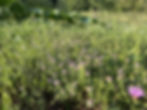Majčina Dušica: Bosnia’s Wild Thyme and Its Centuries-Old Healing Tradition
- Lamija Memidzan
- 7 hours ago
- 4 min read
Editor’s note: The following article is a personal account blending cultural history, traditional herbal knowledge, and personal discovery. It offers insight into majčina dušica — also known as wild thyme — and its enduring role in Bosnian life. While rich in tradition, this article is for informational purposes only and not medical advice.

This summer I spent long, scorching days drenched by the sun in Bosnia and Herzegovina, the country from which my family hails. It was my first time travelling there on my own–without the weight of watchful eyes or rigid schedules. In that time, I began to unravel my family's history through their daily tea rituals that I often overlooked up until that point.
The Healing Landscape of Bosnia
Powerful herbs scatter Bosnia and Herzegovina's many meadows, mountains, and forests. These herbs may be used for virtually every malady–from treating cuts and gashes to the nastiest of stomach aches. One herb in particular, known as majčina dušica (Thymus serpyllum L.), is a plant of great cultural and medicinal value.
History, Benefits, and Cultural Meaning
These days, Bosnia is widely known for the war that ravaged the country during the 1990s. Countless families fled, my own included. This ancestral knowledge drifted like a gust across continents along with its diaspora. During the war, numerous sieges cut off access and supplies to vital resources. Medical and emergency services were devastatingly far and few in between. As a result, traditional medicines were heavily relied upon during and afterwards.
Majčina Dušica: A Mother’s Soul
Majčina dušica is loosely translated to "a mother's soul." Benjamin Sirčo, a retired Commander in the Bosnian military, shares that "majčina dušica has been used for thousands of years–mainly in children for stomach and digestive issues." To his knowledge, it is named majčina dušica for the relief it provides to mothers whose children struggle to sleep through the night as a result of their symptoms.
Gathering and Preserving the Herb
Growing to about 2-3 inches in height with a woody base and small lilac florets, this herb may go undetected to the untrained eye. Its clustered growth is reminiscent of the culture's palpable social interconnectedness. When gathering, I pay careful attention to cutting or pinching the plant before its base. This way, the plant can regenerate and continue providing future generations with relief.
It's believed that majčina dušica is at its most potent when picked fresh and dried. Best enjoyed as a tea, when steeped long enough, its translucent green tint can be mistaken for an incandescent potion.

Herbal Remedies in Wartime Bosnia
Rasema Sirčo, a mathematics and information sciences teacher at Visoko High School, recalls that during the war, "people drank teas much more often and frequently drank majčina dušica. Factories were also closed, so there was much less pollution, and the area was much cleaner– especially where there were no war activities." Where there were no grenades and active military operations, family and friends gathered to collect the necessary flora and fauna to supplement what they lacked in medical supplies.
Sirčo shares that people used natural remedies more often during times of conflict due to the lack of medicine and supplies available. Dependence on the immediate environment rose and led to an increased supplement of holistic remedies. Though bonds with the natural environment were present in Bosnian culture long before the war, these practices grew in necessity during times of scarcity.

Modern Uses Beyond Tea
This variety of wild thyme is still used in households today and is often also concentrated into essential oils and tinctures. Beyond its use in teas, it is also frequently used as a spice for soups, salads, sauces, and other dishes. With its unique and aromatic flavor, it has a broad appeal, making it relatively easy to spot in a random field or a neighbor's backyard.
Majčina dušica is most frequently used to treat respiratory and stomach troubles–though non-conventional applications include use as an antiseptic, an eczema treatment, and swelling reduction.[1] This may not come as a surprise, however, to the generations of populations already implementing these remedies.
A Tradition Passed Down Through Generations
Long before the landslide of publications and formal research on majčina dušica, its history and applications were the responsibility of each generation to pass on to the next. Strong community and social ties were imperative, and still are, to the appreciation of this multi-faceted plant. I, myself, would not have known of this healing tonic had I not spent drinking tea daily with family, prodding for more information on the plants my uncle would gather. In this way, the metaphorical herbal bouquet of ritual was passed down from one generation to the next.
Majčina dušica is deeply ingrained in the space of cultural memory. It is reminiscent of long summer days where relief from the searing sun arrives only with nightfall. A tried and true remedy that symbolizes a saving grace for the challenging, the joyful, and the in-between.
Majčina dušica is only a small part of the rich and deep sea of Bosnian history. Though for me, it played a central role this summer in understanding the landscape that shielded my family and provided protection, if only for another day. In an age of limitless information at our fingertips, it is generational knowledge that has already proven to stand the test of time.
Editor's Note:
How to Prepare Majčina Dušica Tea
Use 1 tablespoon of leaves and florets per 16 oz of boiling water
Steep for 10–15 minutes
Literature
Jarić S, Mitrović M, Pavlović P. Review of Ethnobotanical, Phytochemical, and Pharmacological Study of Thymus serpyllum L. Evid Based Complement Alternat Med. 2015;2015:101978. doi: 10.1155/2015/101978. Epub 2015 Jul 22.
About the Author: Lamija is a Chicago-based writer passionate about culture, the environment, and exploring the unconventional.




















